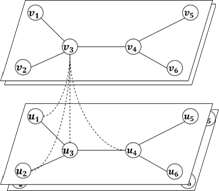Method for processing graph data through quantum graph convolutional neural network
A convolutional neural network and graph data technology, which is applied in the fields of artificial intelligence, machine learning and quantum computing, can solve problems such as different local structures, quantum neural network models not suitable for graph data, and graph data irregularities, etc., to achieve enhanced expression Ability, Efficient Aggregation, Effects of Extended Applicability
- Summary
- Abstract
- Description
- Claims
- Application Information
AI Technical Summary
Problems solved by technology
Method used
Image
Examples
Embodiment 1
[0040] refer to figure 1 , the present embodiment provides a method for processing graph data by a quantum graph convolutional neural network, comprising the following steps:
[0041]S1: Obtain the image data of the image processing task in machine learning, identify the graph structure of the image to obtain the input image data, establish an image processing data set, including the input image data and its corresponding target output, and divide the data set into training set and test set;
[0042] S2: Preprocess the input graph data in the dataset and uniformly encode the nodes and edges in the input graph data;
[0043] In this embodiment, the preprocessing of graph data mainly includes: preprocessing dirty data that contains missing values, inconsistent formats, logic errors, and non-actual requirements; expanding the dimension of input data that does not meet the dimension requirements, so as to The dimension of the input data is equal to the dimension that can be enc...
Embodiment 2
[0099] Such as Figure 6 As shown, the present embodiment also provides a training method for a quantum graph convolutional neural network, comprising the following steps:
[0100] S1: Obtain the training data set of the machine learning task, preprocess and uniformly encode the input image data;
[0101] S2: Initialize the parameters of the quantum graph convolutional neural network model constructed in Example 1;
[0102] S3: Determine the data type of the graph data in the training set, and prepare or input the quantum state according to different data types; among them, for the classical graph data, use the quantum state preparation method to encode it into qubits of corresponding information; for quantum data, which can be read directly as input data;
[0103] S4: Input the output quantum state to the quantum graph convolution layer of the quantum graph convolution module of the quantum graph convolutional neural network model and run it;
[0104] S5: Input the operati...
Embodiment 3
[0109] This embodiment provides a method of using the quantum graph convolutional neural network of the present invention to process graph data to realize a graph classification task, including:
[0110] Obtain the dataset needed to implement the graph classification task;
[0111] Call the last saved quantum graph convolutional neural network model after training;
[0112] Input the obtained data to be classified into the quantum graph convolutional neural network model for classification, and obtain the classification result of the machine learning graph classification task.
PUM
 Login to View More
Login to View More Abstract
Description
Claims
Application Information
 Login to View More
Login to View More - R&D
- Intellectual Property
- Life Sciences
- Materials
- Tech Scout
- Unparalleled Data Quality
- Higher Quality Content
- 60% Fewer Hallucinations
Browse by: Latest US Patents, China's latest patents, Technical Efficacy Thesaurus, Application Domain, Technology Topic, Popular Technical Reports.
© 2025 PatSnap. All rights reserved.Legal|Privacy policy|Modern Slavery Act Transparency Statement|Sitemap|About US| Contact US: help@patsnap.com



